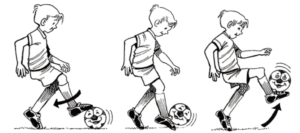Coaching Sequence
The genius of good coaching is to make hard work seem like FUN!
Your practices must duplicate the excitement of the game. You must create an environment that forces the players to make their own decisions. You must create an atmosphere where the players are allowed to teach themselves. You must create an environment that develops instinctive attacking and defending habits.
This can be accomplished by asking yourself
DOES IT HAPPEN IN THE GAME?
If the answer is NO, then DON’T DO IT IN PRACTICE
Your practice will no longer be:
- Too simple because players will get bored.
- Too complex because players will get confused.
Your practice will now be creative so that learning will continuously take place.
Throughout the Coaching Sequence, you must:
- Be Patient: You cannot expect immediate results.
- Be Persistent: It will take time and effective repetition.
- Be Flexible! So that you can maintain players’ interest when working on a particular soccer technique.
- Maintain a Sense of Humor! The players should work in a relaxed atmosphere.
- Reward the Players! With a positive reaction, a positive comment, a positive smile
Remember, everything takes time to learn!
Before Practice
ARRIVE EARLY

- Check weather and field conditions
- Greet the players and encourage them to socialize with each other
JUGGLING
Tap it with the Toes

This is a terrific idea to add ball gymnastics to the pre-practice routine. Juggling gives them a fun personal challenge that helps them feel for movement and coordination of/with the ball. In time, their ball control problems will go away!
1. Explanation
- Take into consideration the attention span of your players and adjust the length of your expectation accordingly. BE BRIEF!
- After you have dealt with a point, ask questions to make sure the point was understood. Repeat the verbal instructions only if necessary. BE BRIEF!

- Communicate in simple, everyday language. Create and use “buzz words”, words that trigger the mind to highlight points of emphasis. For example:
Push
Stop
Change Direction

2. Demonstration
- Give a demonstration – slowly, simply, and technically correct. Make it completely clear what points the demonstration is intended to bring out.

- Important: If you are unable to demonstrate, then have the guest instructor or one of your better players do the demonstration for you!
- While the demonstration is taking place, make sure that everything can be seen clearly by all players.

3. Touching
4. Visualizing
3. Touching
- As the demonstration and explanation are taking place, have the players make contact with (touch) the part of the shoe or body that will come into play when they perform the technique.

- This helps in programming the brain and muscles to work together.
- After the demonstration and explanation, have the players close their eyes and imagine themselves performing the technique correctly and proficiently.

- This powerful method is currently being used by many international athletes who realize that the body can better achieve what the mind has first rehearsed.
4. Visualizing
- After the demonstration and explanation, have the players close their eyes and imagine themselves performing the technique correctly and proficiently.

- This powerful method is currently being used by many international athletes who realize that the body can better achieve what the mind has first rehearsed.
5. Self-Talk
- As they are visualizing, have the players repeat the “buzz words” out loud.

- They will let you know if they are just resting their eyes, or if they listened to your questions and are indeed visualizing techniques.
6. Action
- After using these confidence building tools, perform the technique using the “Stages of Play.”
- The Stages of Play are:
1. Work with/against a walking partner
2. Work with/against a jogging partner
3. work with/against a partner playing at game speed
- Having a partner increases preassure as the players’ confidence and ability increase. Activity, good repetition, experimentation, and enjoyment lead to success.
7. Observe
5. Self-Talk
6. Action
- As they are visualizing, have the players repeat the “buzz words” out loud.

- They will let you know if they are just resting their eyes, or if they listened to your questions and are indeed visualizing techniques.
- After using these confidence-building tools, perform the technique using the “Stages of Play.”
- The Stages of Play are:
1. Work with/against a walking partner
2. Work with/against a jogging partner
3. work with/against a partner playing at game speed - Having a partner increases pressure as the players’ confidence and ability increase. Activity, good repetition, experimentation, and enjoyment lead to success.
7. Observe
- As the players experiment with performing the technique, look for weaknesses in execution of the movement or technique


- Very Important: Discipline your mind to focus only on what is being taught. Ignore all other mistakes!
- Avoid causing Paralysis through Analysis
8. Correct
- Consistent basic faults can be corrected by:

When in doubt, go back to the basics; break down the skill to its individual parts. In all cases, restart with the correct move or maneuver.
9. Test
10. Confirm
9. Test
Perform the technique against opposition
- first with one opponent (1 vs 1 game)
- then with more opponents (small-sided game)
- finally, with the full team (scrimmage)
Helpful Hint: Be careful that in the haste of competing, the technique does not deteriorate.
- Critique to see what learning has taken place!

10. Confirm
- Critique to see what learning has taken place!

Up Next: The 9 Step Practice –








